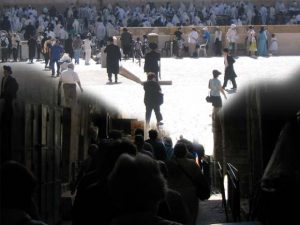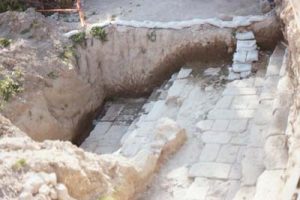by Mary Okkema
Now when Solomon had finished praying, fire came down from heaven and consumed the burnt offering and the sacrifices, and the glory of the LORD filled the house. The priests could not enter into the house of the LORD because the glory of the LORD filled the LORD’S house. All the sons of Israel, seeing the fire come down and the glory of the LORD upon the house, bowed down on the pavement with their faces to the ground, and they worshiped and gave praise to the LORD, saying, “Truly He is good, truly His lovingkindness is everlasting. – II Chronicles 7:1-3
During our recent trip to Jerusalem we were privileged to visit the Temple Mount. We stood on paving stones which were bright white. The sunny day made it so that it was almost impossible to see without covering our eyes. We discussed the construction materials of the Temple, its courts and the fact that when a pilgrim would surface from the dark tunnels leading up into the Temple courtyard the contrast would be blinding.
Josephus describes the materials used in the Temple construction this way. “Now the temple was built of stones that were white and strong,” (1) And another of his writings says it this way. “But this temple appeared to strangers, when they were at a distance, like a mountain covered with snow; for as those parts of it that were not gilt, they were exceeding white.” (2)
Bright white and glory of the Lord are synonymous in the history of this place. In 1 Timothy 6:16 we read, “who alone possesses immortality and dwells in unapproachable light,” referencing Psalm 104:1 which says,” Bless the LORD, O my soul! O LORD my God, You are very great; You are clothed with splendor and majesty, covering Yourself with light as with a cloak,”
Even though the Temple no longer stands, we had a brief glimpse as to how it would have looked to pilgrims as they approached this holy place of “exceeding white.” We look forward to the time when in the new Jerusalem there will be “a great multitude which no one could count, from every nation and all tribes and peoples and tongues, standing before the throne and before the Lamb, clothed in white robes,” (Rev. 7:9) But in that day it will be said: “I saw no temple in it, for the Lord God the Almighty and the Lamb are its temple.” (Rev 21:22)
We will then experience the brightness of His presence. “the city has no need of the sun or of the moon to shine on it, for the glory of God has illumined it”! (Rev 21:23)
(1) Josephus, Jewish Antiquities, Book 15, Chapter 11
(2) Josephus, Wars of the Jews, Book. 5, Chapter 5, Section 6



